Dynamic Leadership: A Reflective Approach
VerifiedAdded on 2023/01/13
|13
|2372
|39
AI Summary
This paper discusses the author's own perception towards the leadership style and application of the same in own workplace. It focuses on the theoretical framework and concludes accordingly.
Contribute Materials
Your contribution can guide someone’s learning journey. Share your
documents today.
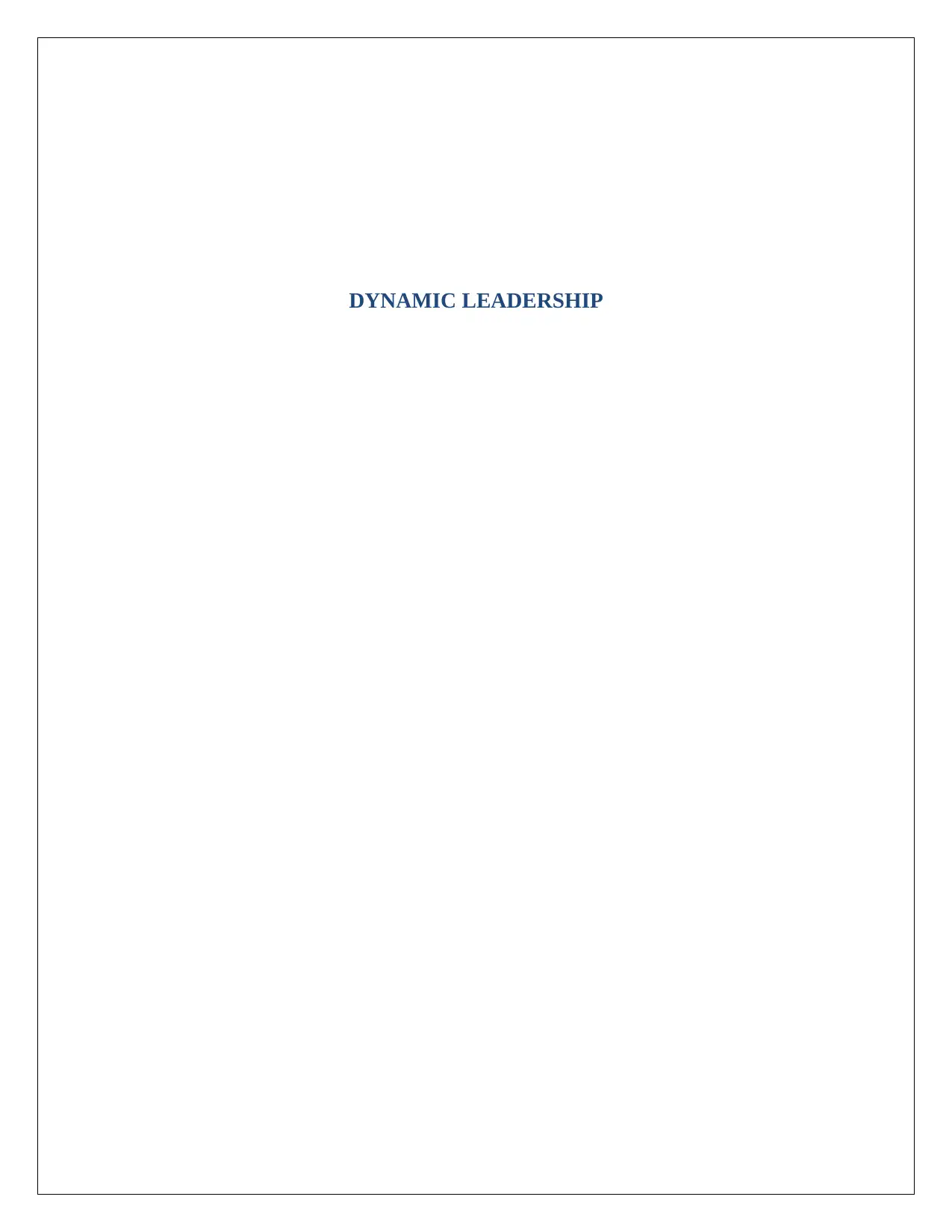
DYNAMIC LEADERSHIP
Secure Best Marks with AI Grader
Need help grading? Try our AI Grader for instant feedback on your assignments.
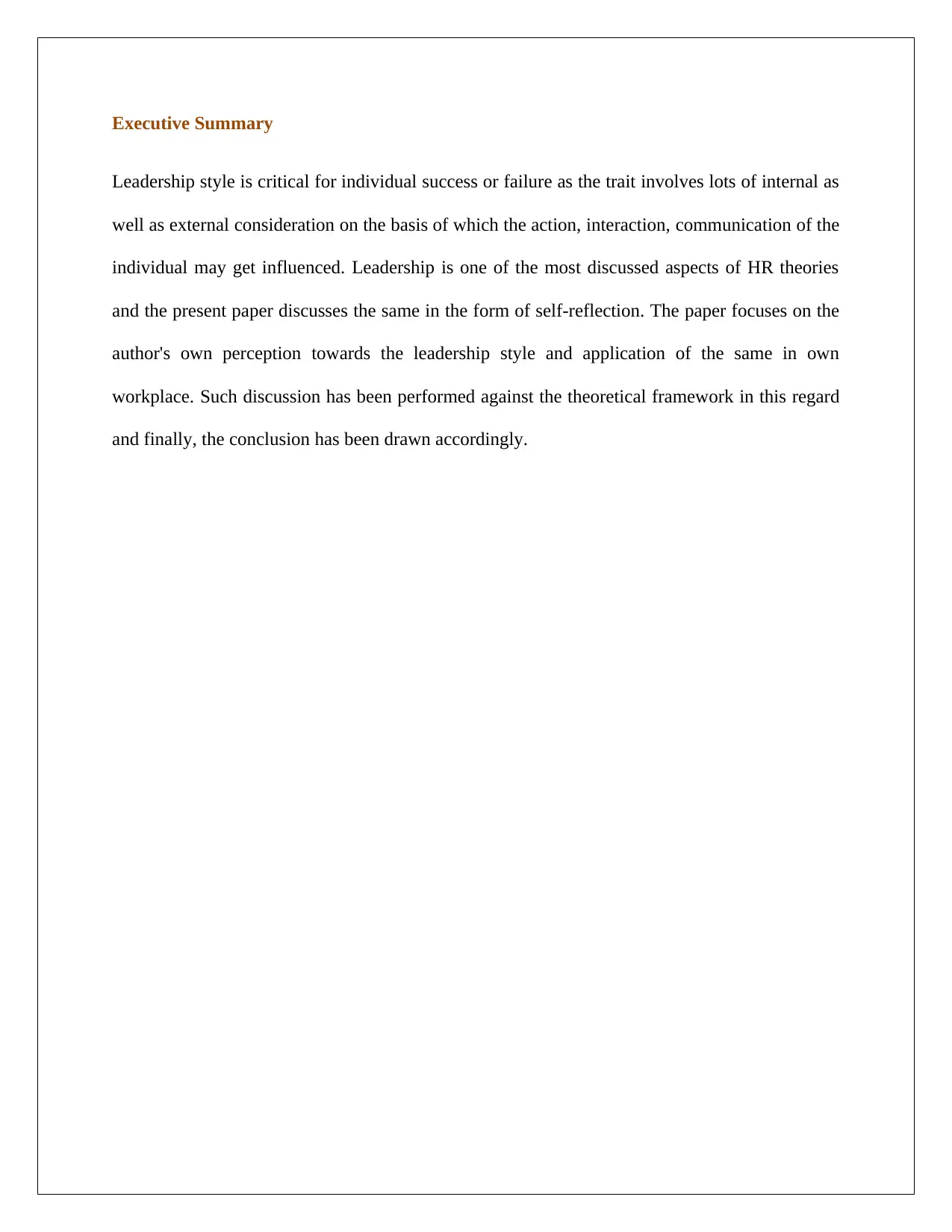
Executive Summary
Leadership style is critical for individual success or failure as the trait involves lots of internal as
well as external consideration on the basis of which the action, interaction, communication of the
individual may get influenced. Leadership is one of the most discussed aspects of HR theories
and the present paper discusses the same in the form of self-reflection. The paper focuses on the
author's own perception towards the leadership style and application of the same in own
workplace. Such discussion has been performed against the theoretical framework in this regard
and finally, the conclusion has been drawn accordingly.
Leadership style is critical for individual success or failure as the trait involves lots of internal as
well as external consideration on the basis of which the action, interaction, communication of the
individual may get influenced. Leadership is one of the most discussed aspects of HR theories
and the present paper discusses the same in the form of self-reflection. The paper focuses on the
author's own perception towards the leadership style and application of the same in own
workplace. Such discussion has been performed against the theoretical framework in this regard
and finally, the conclusion has been drawn accordingly.

Table of Contents
1.0 Introduction................................................................................................................................4
2.0 Dynamic Leadership: A Reflective Approach...........................................................................5
2.1 My Current Roles, Responsibilities and Leadership Challenges...........................................5
2.2 Key Aspects of My Leadership Journey So Far....................................................................5
2.3 Results of the Strengths Finder Test......................................................................................6
2.4 Key Feedback Points from Others.........................................................................................7
2.5 The Implications of the Feedback..........................................................................................8
2.6 Link to the Theory..................................................................................................................9
3.0 Conclusion...............................................................................................................................12
References......................................................................................................................................13
1.0 Introduction................................................................................................................................4
2.0 Dynamic Leadership: A Reflective Approach...........................................................................5
2.1 My Current Roles, Responsibilities and Leadership Challenges...........................................5
2.2 Key Aspects of My Leadership Journey So Far....................................................................5
2.3 Results of the Strengths Finder Test......................................................................................6
2.4 Key Feedback Points from Others.........................................................................................7
2.5 The Implications of the Feedback..........................................................................................8
2.6 Link to the Theory..................................................................................................................9
3.0 Conclusion...............................................................................................................................12
References......................................................................................................................................13
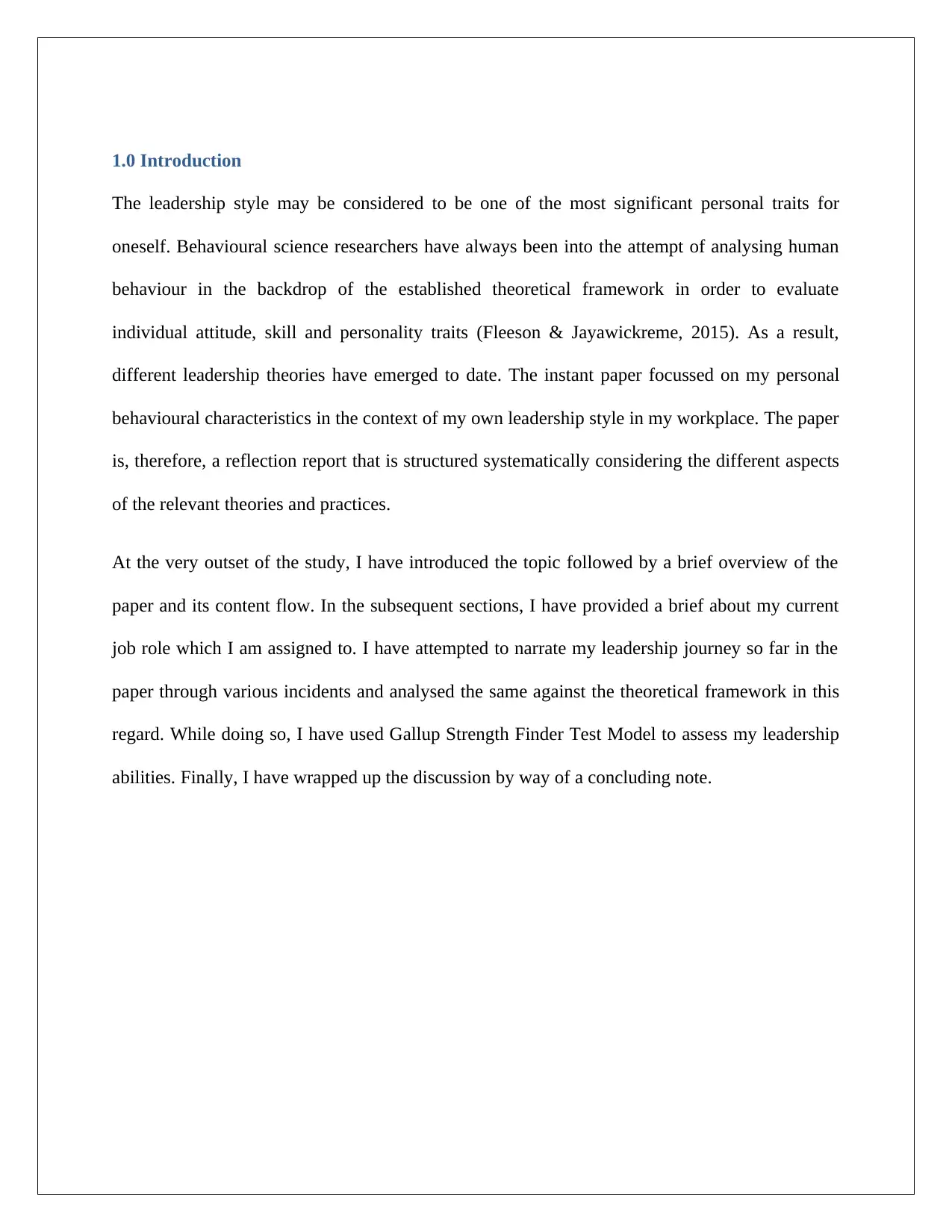
1.0 Introduction
The leadership style may be considered to be one of the most significant personal traits for
oneself. Behavioural science researchers have always been into the attempt of analysing human
behaviour in the backdrop of the established theoretical framework in order to evaluate
individual attitude, skill and personality traits (Fleeson & Jayawickreme, 2015). As a result,
different leadership theories have emerged to date. The instant paper focussed on my personal
behavioural characteristics in the context of my own leadership style in my workplace. The paper
is, therefore, a reflection report that is structured systematically considering the different aspects
of the relevant theories and practices.
At the very outset of the study, I have introduced the topic followed by a brief overview of the
paper and its content flow. In the subsequent sections, I have provided a brief about my current
job role which I am assigned to. I have attempted to narrate my leadership journey so far in the
paper through various incidents and analysed the same against the theoretical framework in this
regard. While doing so, I have used Gallup Strength Finder Test Model to assess my leadership
abilities. Finally, I have wrapped up the discussion by way of a concluding note.
The leadership style may be considered to be one of the most significant personal traits for
oneself. Behavioural science researchers have always been into the attempt of analysing human
behaviour in the backdrop of the established theoretical framework in order to evaluate
individual attitude, skill and personality traits (Fleeson & Jayawickreme, 2015). As a result,
different leadership theories have emerged to date. The instant paper focussed on my personal
behavioural characteristics in the context of my own leadership style in my workplace. The paper
is, therefore, a reflection report that is structured systematically considering the different aspects
of the relevant theories and practices.
At the very outset of the study, I have introduced the topic followed by a brief overview of the
paper and its content flow. In the subsequent sections, I have provided a brief about my current
job role which I am assigned to. I have attempted to narrate my leadership journey so far in the
paper through various incidents and analysed the same against the theoretical framework in this
regard. While doing so, I have used Gallup Strength Finder Test Model to assess my leadership
abilities. Finally, I have wrapped up the discussion by way of a concluding note.
Secure Best Marks with AI Grader
Need help grading? Try our AI Grader for instant feedback on your assignments.
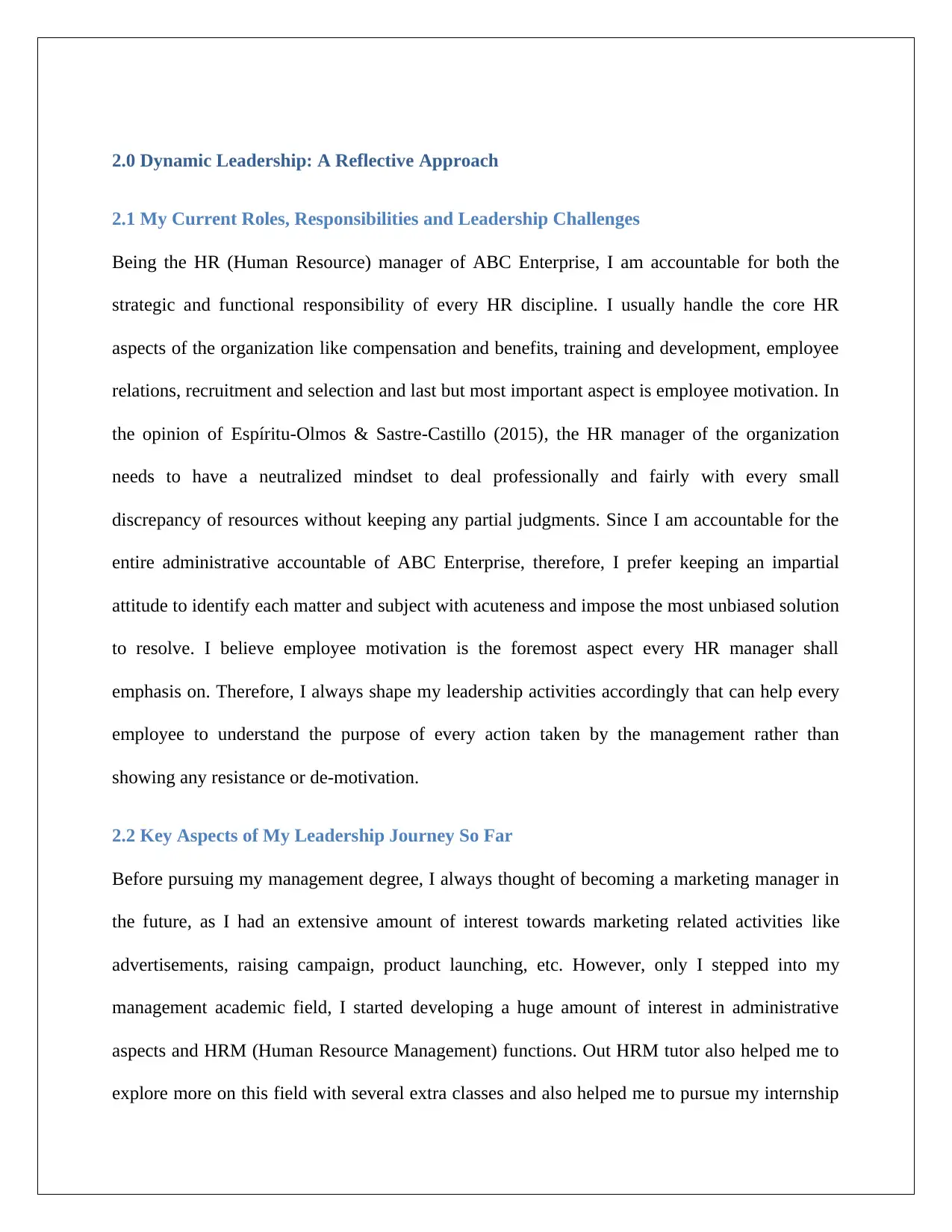
2.0 Dynamic Leadership: A Reflective Approach
2.1 My Current Roles, Responsibilities and Leadership Challenges
Being the HR (Human Resource) manager of ABC Enterprise, I am accountable for both the
strategic and functional responsibility of every HR discipline. I usually handle the core HR
aspects of the organization like compensation and benefits, training and development, employee
relations, recruitment and selection and last but most important aspect is employee motivation. In
the opinion of Espíritu-Olmos & Sastre-Castillo (2015), the HR manager of the organization
needs to have a neutralized mindset to deal professionally and fairly with every small
discrepancy of resources without keeping any partial judgments. Since I am accountable for the
entire administrative accountable of ABC Enterprise, therefore, I prefer keeping an impartial
attitude to identify each matter and subject with acuteness and impose the most unbiased solution
to resolve. I believe employee motivation is the foremost aspect every HR manager shall
emphasis on. Therefore, I always shape my leadership activities accordingly that can help every
employee to understand the purpose of every action taken by the management rather than
showing any resistance or de-motivation.
2.2 Key Aspects of My Leadership Journey So Far
Before pursuing my management degree, I always thought of becoming a marketing manager in
the future, as I had an extensive amount of interest towards marketing related activities like
advertisements, raising campaign, product launching, etc. However, only I stepped into my
management academic field, I started developing a huge amount of interest in administrative
aspects and HRM (Human Resource Management) functions. Out HRM tutor also helped me to
explore more on this field with several extra classes and also helped me to pursue my internship
2.1 My Current Roles, Responsibilities and Leadership Challenges
Being the HR (Human Resource) manager of ABC Enterprise, I am accountable for both the
strategic and functional responsibility of every HR discipline. I usually handle the core HR
aspects of the organization like compensation and benefits, training and development, employee
relations, recruitment and selection and last but most important aspect is employee motivation. In
the opinion of Espíritu-Olmos & Sastre-Castillo (2015), the HR manager of the organization
needs to have a neutralized mindset to deal professionally and fairly with every small
discrepancy of resources without keeping any partial judgments. Since I am accountable for the
entire administrative accountable of ABC Enterprise, therefore, I prefer keeping an impartial
attitude to identify each matter and subject with acuteness and impose the most unbiased solution
to resolve. I believe employee motivation is the foremost aspect every HR manager shall
emphasis on. Therefore, I always shape my leadership activities accordingly that can help every
employee to understand the purpose of every action taken by the management rather than
showing any resistance or de-motivation.
2.2 Key Aspects of My Leadership Journey So Far
Before pursuing my management degree, I always thought of becoming a marketing manager in
the future, as I had an extensive amount of interest towards marketing related activities like
advertisements, raising campaign, product launching, etc. However, only I stepped into my
management academic field, I started developing a huge amount of interest in administrative
aspects and HRM (Human Resource Management) functions. Out HRM tutor also helped me to
explore more on this field with several extra classes and also helped me to pursue my internship
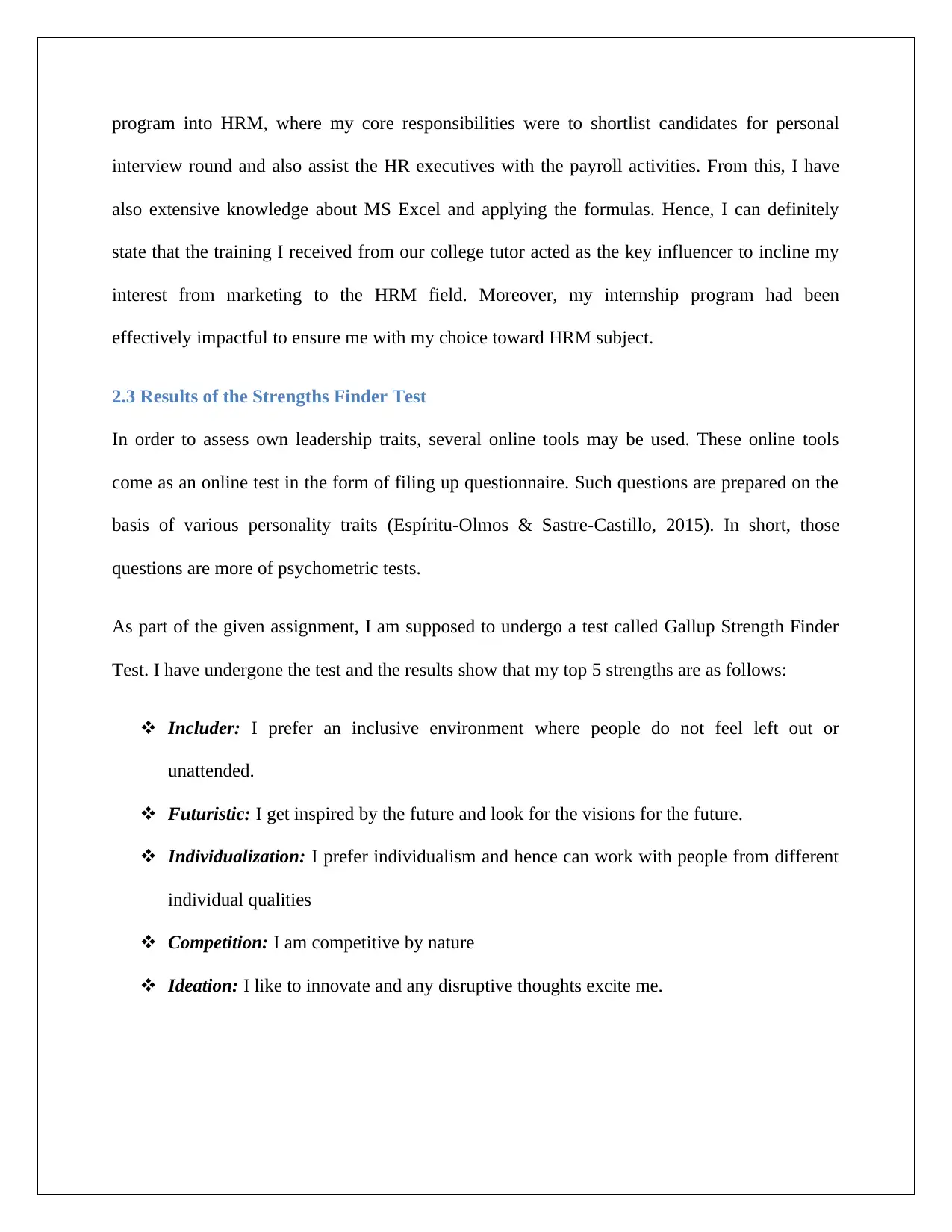
program into HRM, where my core responsibilities were to shortlist candidates for personal
interview round and also assist the HR executives with the payroll activities. From this, I have
also extensive knowledge about MS Excel and applying the formulas. Hence, I can definitely
state that the training I received from our college tutor acted as the key influencer to incline my
interest from marketing to the HRM field. Moreover, my internship program had been
effectively impactful to ensure me with my choice toward HRM subject.
2.3 Results of the Strengths Finder Test
In order to assess own leadership traits, several online tools may be used. These online tools
come as an online test in the form of filing up questionnaire. Such questions are prepared on the
basis of various personality traits (Espíritu-Olmos & Sastre-Castillo, 2015). In short, those
questions are more of psychometric tests.
As part of the given assignment, I am supposed to undergo a test called Gallup Strength Finder
Test. I have undergone the test and the results show that my top 5 strengths are as follows:
Includer: I prefer an inclusive environment where people do not feel left out or
unattended.
Futuristic: I get inspired by the future and look for the visions for the future.
Individualization: I prefer individualism and hence can work with people from different
individual qualities
Competition: I am competitive by nature
Ideation: I like to innovate and any disruptive thoughts excite me.
interview round and also assist the HR executives with the payroll activities. From this, I have
also extensive knowledge about MS Excel and applying the formulas. Hence, I can definitely
state that the training I received from our college tutor acted as the key influencer to incline my
interest from marketing to the HRM field. Moreover, my internship program had been
effectively impactful to ensure me with my choice toward HRM subject.
2.3 Results of the Strengths Finder Test
In order to assess own leadership traits, several online tools may be used. These online tools
come as an online test in the form of filing up questionnaire. Such questions are prepared on the
basis of various personality traits (Espíritu-Olmos & Sastre-Castillo, 2015). In short, those
questions are more of psychometric tests.
As part of the given assignment, I am supposed to undergo a test called Gallup Strength Finder
Test. I have undergone the test and the results show that my top 5 strengths are as follows:
Includer: I prefer an inclusive environment where people do not feel left out or
unattended.
Futuristic: I get inspired by the future and look for the visions for the future.
Individualization: I prefer individualism and hence can work with people from different
individual qualities
Competition: I am competitive by nature
Ideation: I like to innovate and any disruptive thoughts excite me.

2.4 Key Feedback Points from Others
Since I always kept myself proactive in the workplace and ever tried to provide proactive
judgment towards the team members' actions or performances. Therefore, the members of every
department show a respectful and positive attitude towards my judgments. I believe that
employees shall be given adequate scope to feel free in terms of placing their inputs and discuss
the problems they are facing with the regular operations. Hence, without fail, I prefer conducting
a monthly engagement session with every department, where the employees made free to place
their opinions against the given tasks and they are also allowed to propose probable solution
against the identified gaps. Thus, I maintain an interactive session, where employees feel valued
for getting sufficient importance by the HR manager and they also show interests in taking
additional responsibilities. I also conduct a frequent training session for each department, where
employees are given several demo cases or situations to solve. This usually led to a
brainstorming session where employees use their individual idea and creative aspects to resolve
the given cases. Hence, their skills and expertise are nurtured on a regular basis. Therefore, being
the HRM leader of the chosen enterprise, I manage to focus on every single activity that leads to
employee evolvement, motivation and creates a positive working environment.
2.5 The Implications of the Feedback
Nevertheless, I have a very competitive nature, which sometimes reverts back when my team
members feel extremely pressurized with immense work burdens. This has been my loophole,
where, I focus on keeping the resources always motivated, on the contrary, fail to spread the
same energy amongst my subordinates.
This is where I as a leader need to improve. On an additional note, I also sometimes stretch the
theoretical aspects more on training class, which sometimes become extremely monotonous for
Since I always kept myself proactive in the workplace and ever tried to provide proactive
judgment towards the team members' actions or performances. Therefore, the members of every
department show a respectful and positive attitude towards my judgments. I believe that
employees shall be given adequate scope to feel free in terms of placing their inputs and discuss
the problems they are facing with the regular operations. Hence, without fail, I prefer conducting
a monthly engagement session with every department, where the employees made free to place
their opinions against the given tasks and they are also allowed to propose probable solution
against the identified gaps. Thus, I maintain an interactive session, where employees feel valued
for getting sufficient importance by the HR manager and they also show interests in taking
additional responsibilities. I also conduct a frequent training session for each department, where
employees are given several demo cases or situations to solve. This usually led to a
brainstorming session where employees use their individual idea and creative aspects to resolve
the given cases. Hence, their skills and expertise are nurtured on a regular basis. Therefore, being
the HRM leader of the chosen enterprise, I manage to focus on every single activity that leads to
employee evolvement, motivation and creates a positive working environment.
2.5 The Implications of the Feedback
Nevertheless, I have a very competitive nature, which sometimes reverts back when my team
members feel extremely pressurized with immense work burdens. This has been my loophole,
where, I focus on keeping the resources always motivated, on the contrary, fail to spread the
same energy amongst my subordinates.
This is where I as a leader need to improve. On an additional note, I also sometimes stretch the
theoretical aspects more on training class, which sometimes become extremely monotonous for
Paraphrase This Document
Need a fresh take? Get an instant paraphrase of this document with our AI Paraphraser
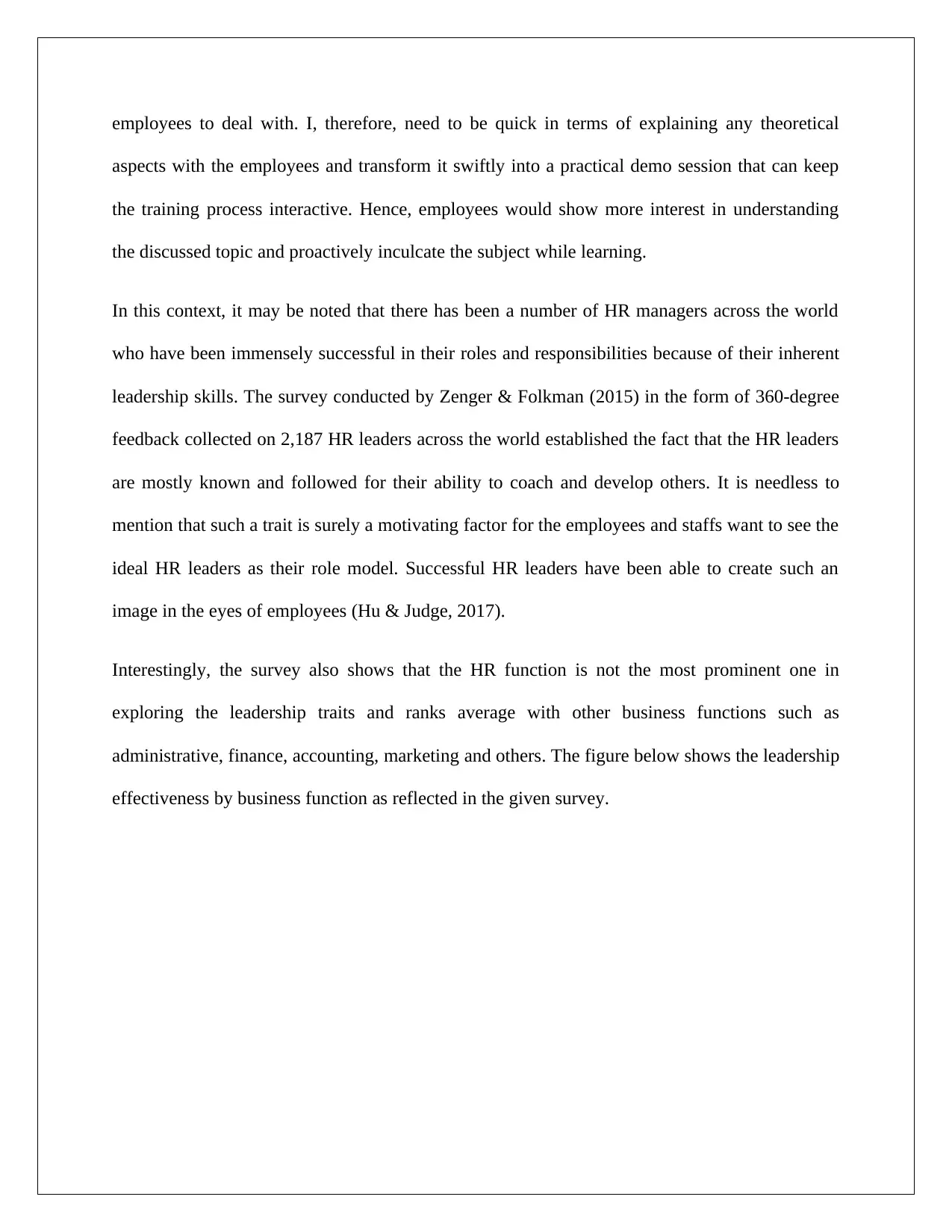
employees to deal with. I, therefore, need to be quick in terms of explaining any theoretical
aspects with the employees and transform it swiftly into a practical demo session that can keep
the training process interactive. Hence, employees would show more interest in understanding
the discussed topic and proactively inculcate the subject while learning.
In this context, it may be noted that there has been a number of HR managers across the world
who have been immensely successful in their roles and responsibilities because of their inherent
leadership skills. The survey conducted by Zenger & Folkman (2015) in the form of 360-degree
feedback collected on 2,187 HR leaders across the world established the fact that the HR leaders
are mostly known and followed for their ability to coach and develop others. It is needless to
mention that such a trait is surely a motivating factor for the employees and staffs want to see the
ideal HR leaders as their role model. Successful HR leaders have been able to create such an
image in the eyes of employees (Hu & Judge, 2017).
Interestingly, the survey also shows that the HR function is not the most prominent one in
exploring the leadership traits and ranks average with other business functions such as
administrative, finance, accounting, marketing and others. The figure below shows the leadership
effectiveness by business function as reflected in the given survey.
aspects with the employees and transform it swiftly into a practical demo session that can keep
the training process interactive. Hence, employees would show more interest in understanding
the discussed topic and proactively inculcate the subject while learning.
In this context, it may be noted that there has been a number of HR managers across the world
who have been immensely successful in their roles and responsibilities because of their inherent
leadership skills. The survey conducted by Zenger & Folkman (2015) in the form of 360-degree
feedback collected on 2,187 HR leaders across the world established the fact that the HR leaders
are mostly known and followed for their ability to coach and develop others. It is needless to
mention that such a trait is surely a motivating factor for the employees and staffs want to see the
ideal HR leaders as their role model. Successful HR leaders have been able to create such an
image in the eyes of employees (Hu & Judge, 2017).
Interestingly, the survey also shows that the HR function is not the most prominent one in
exploring the leadership traits and ranks average with other business functions such as
administrative, finance, accounting, marketing and others. The figure below shows the leadership
effectiveness by business function as reflected in the given survey.

Figure 1: Leadership Effectiveness by Business Functions
(Source: Zenger & Folkman, 2015)
As per the figure, the sales functions represent most of the business leaders as the same involves
a driving force which keeps the sales force of the business motivated and get going. However, in
the current context, it may also be stated that my role as an HR manager has been all-pervasive
and hence involves strategic as a well operational decision-making process.
2.6 Link to the Theory
My reflection can be evaluated with the support of Kolb’s Learning Cycle
Experience
(Source: Zenger & Folkman, 2015)
As per the figure, the sales functions represent most of the business leaders as the same involves
a driving force which keeps the sales force of the business motivated and get going. However, in
the current context, it may also be stated that my role as an HR manager has been all-pervasive
and hence involves strategic as a well operational decision-making process.
2.6 Link to the Theory
My reflection can be evaluated with the support of Kolb’s Learning Cycle
Experience
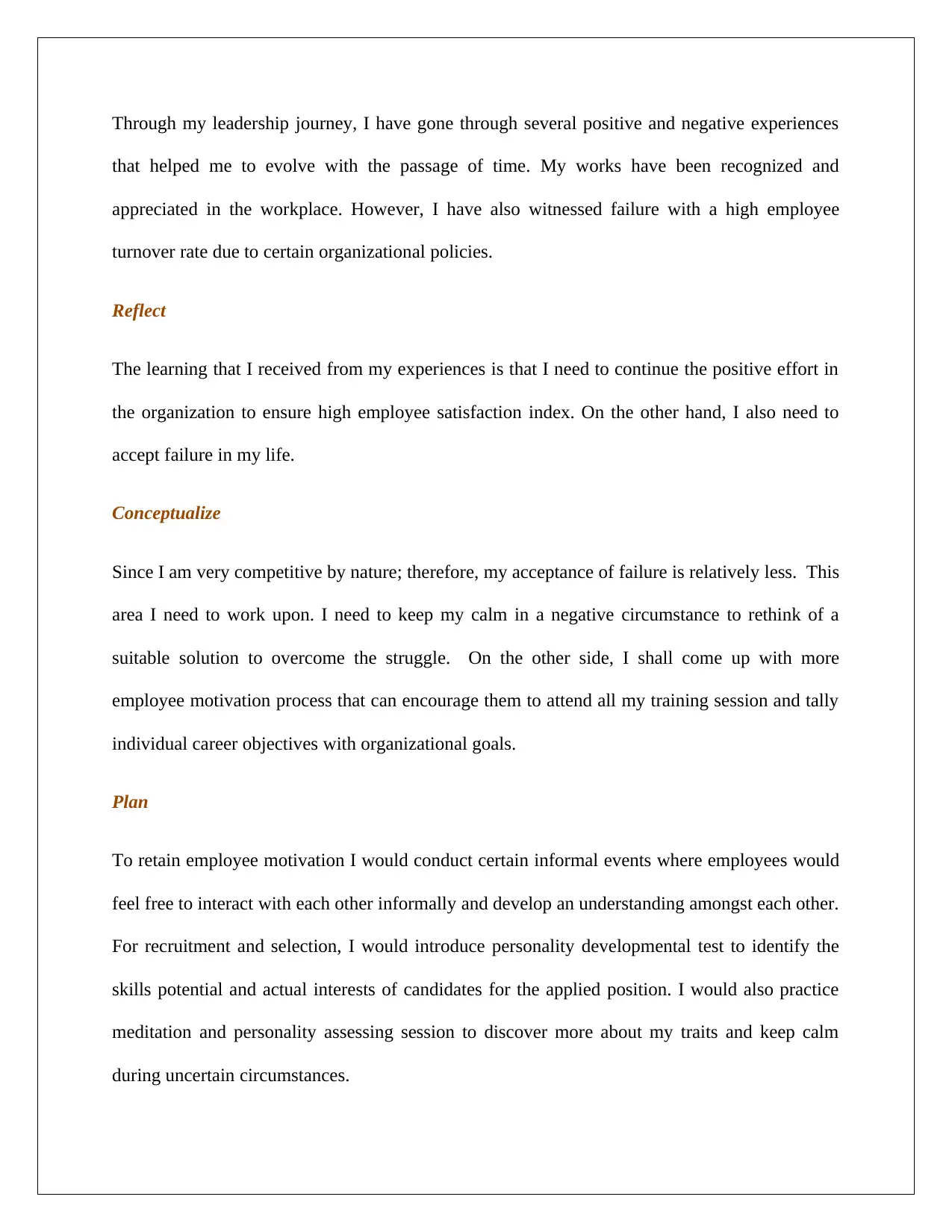
Through my leadership journey, I have gone through several positive and negative experiences
that helped me to evolve with the passage of time. My works have been recognized and
appreciated in the workplace. However, I have also witnessed failure with a high employee
turnover rate due to certain organizational policies.
Reflect
The learning that I received from my experiences is that I need to continue the positive effort in
the organization to ensure high employee satisfaction index. On the other hand, I also need to
accept failure in my life.
Conceptualize
Since I am very competitive by nature; therefore, my acceptance of failure is relatively less. This
area I need to work upon. I need to keep my calm in a negative circumstance to rethink of a
suitable solution to overcome the struggle. On the other side, I shall come up with more
employee motivation process that can encourage them to attend all my training session and tally
individual career objectives with organizational goals.
Plan
To retain employee motivation I would conduct certain informal events where employees would
feel free to interact with each other informally and develop an understanding amongst each other.
For recruitment and selection, I would introduce personality developmental test to identify the
skills potential and actual interests of candidates for the applied position. I would also practice
meditation and personality assessing session to discover more about my traits and keep calm
during uncertain circumstances.
that helped me to evolve with the passage of time. My works have been recognized and
appreciated in the workplace. However, I have also witnessed failure with a high employee
turnover rate due to certain organizational policies.
Reflect
The learning that I received from my experiences is that I need to continue the positive effort in
the organization to ensure high employee satisfaction index. On the other hand, I also need to
accept failure in my life.
Conceptualize
Since I am very competitive by nature; therefore, my acceptance of failure is relatively less. This
area I need to work upon. I need to keep my calm in a negative circumstance to rethink of a
suitable solution to overcome the struggle. On the other side, I shall come up with more
employee motivation process that can encourage them to attend all my training session and tally
individual career objectives with organizational goals.
Plan
To retain employee motivation I would conduct certain informal events where employees would
feel free to interact with each other informally and develop an understanding amongst each other.
For recruitment and selection, I would introduce personality developmental test to identify the
skills potential and actual interests of candidates for the applied position. I would also practice
meditation and personality assessing session to discover more about my traits and keep calm
during uncertain circumstances.
Secure Best Marks with AI Grader
Need help grading? Try our AI Grader for instant feedback on your assignments.
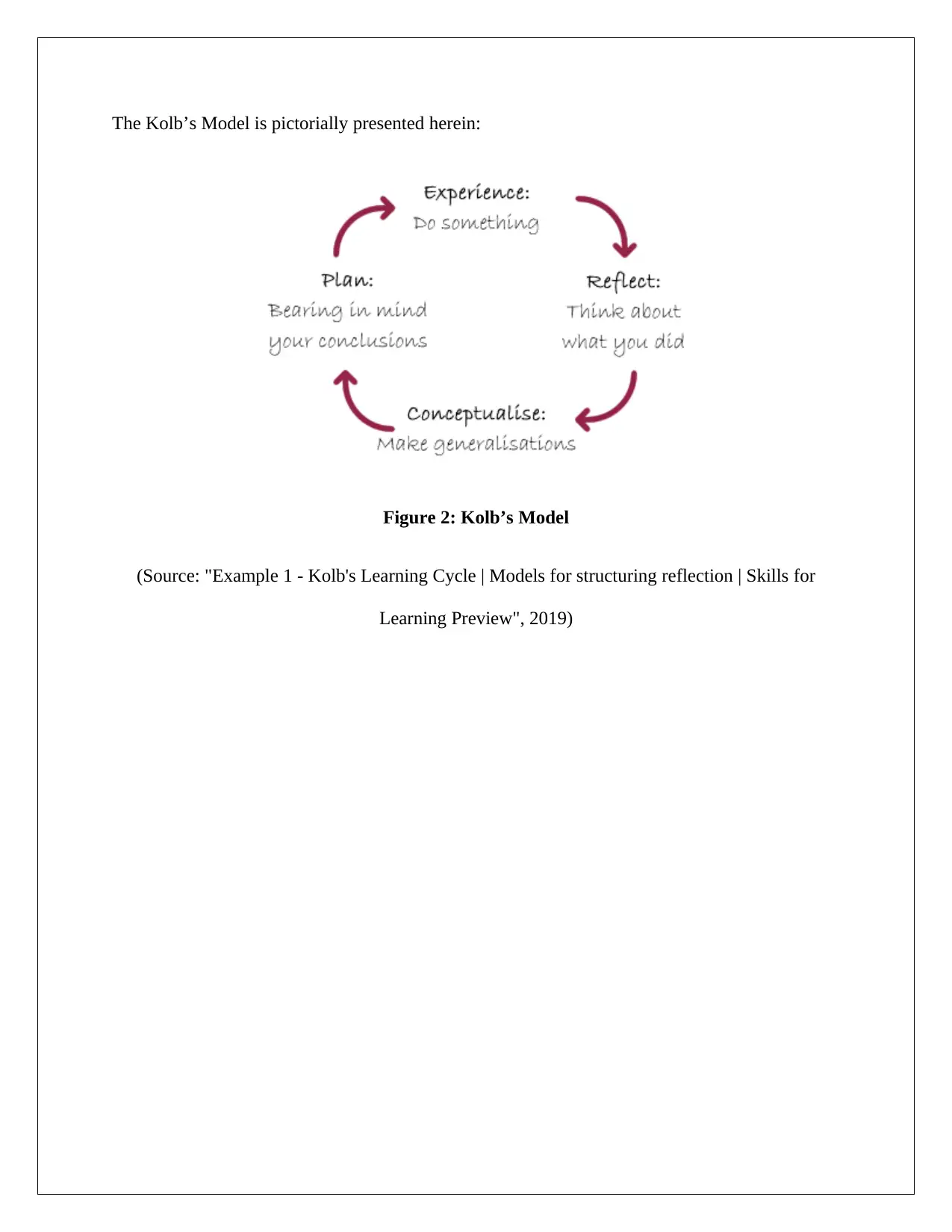
The Kolb’s Model is pictorially presented herein:
Figure 2: Kolb’s Model
(Source: "Example 1 - Kolb's Learning Cycle | Models for structuring reflection | Skills for
Learning Preview", 2019)
Figure 2: Kolb’s Model
(Source: "Example 1 - Kolb's Learning Cycle | Models for structuring reflection | Skills for
Learning Preview", 2019)
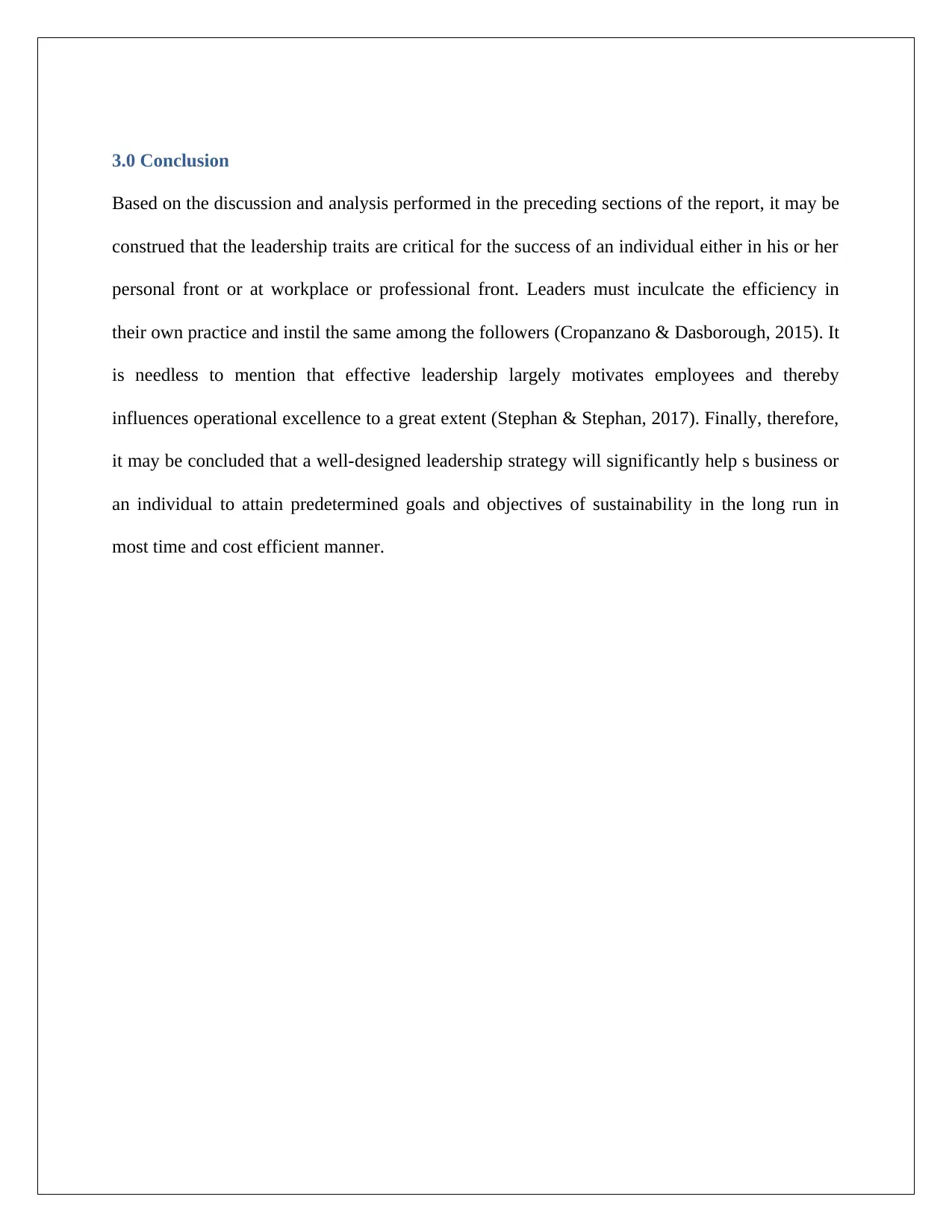
3.0 Conclusion
Based on the discussion and analysis performed in the preceding sections of the report, it may be
construed that the leadership traits are critical for the success of an individual either in his or her
personal front or at workplace or professional front. Leaders must inculcate the efficiency in
their own practice and instil the same among the followers (Cropanzano & Dasborough, 2015). It
is needless to mention that effective leadership largely motivates employees and thereby
influences operational excellence to a great extent (Stephan & Stephan, 2017). Finally, therefore,
it may be concluded that a well-designed leadership strategy will significantly help s business or
an individual to attain predetermined goals and objectives of sustainability in the long run in
most time and cost efficient manner.
Based on the discussion and analysis performed in the preceding sections of the report, it may be
construed that the leadership traits are critical for the success of an individual either in his or her
personal front or at workplace or professional front. Leaders must inculcate the efficiency in
their own practice and instil the same among the followers (Cropanzano & Dasborough, 2015). It
is needless to mention that effective leadership largely motivates employees and thereby
influences operational excellence to a great extent (Stephan & Stephan, 2017). Finally, therefore,
it may be concluded that a well-designed leadership strategy will significantly help s business or
an individual to attain predetermined goals and objectives of sustainability in the long run in
most time and cost efficient manner.
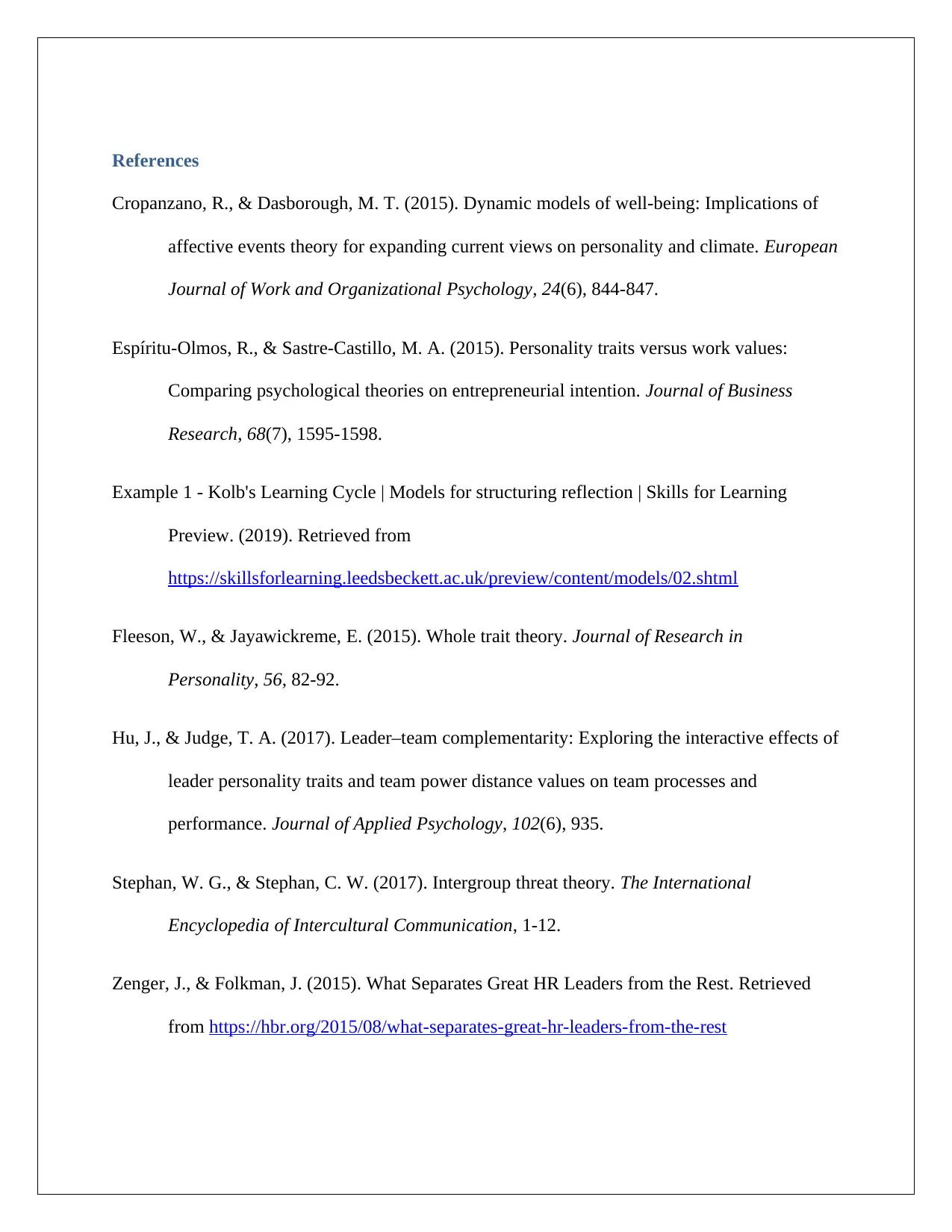
References
Cropanzano, R., & Dasborough, M. T. (2015). Dynamic models of well-being: Implications of
affective events theory for expanding current views on personality and climate. European
Journal of Work and Organizational Psychology, 24(6), 844-847.
Espíritu-Olmos, R., & Sastre-Castillo, M. A. (2015). Personality traits versus work values:
Comparing psychological theories on entrepreneurial intention. Journal of Business
Research, 68(7), 1595-1598.
Example 1 - Kolb's Learning Cycle | Models for structuring reflection | Skills for Learning
Preview. (2019). Retrieved from
https://skillsforlearning.leedsbeckett.ac.uk/preview/content/models/02.shtml
Fleeson, W., & Jayawickreme, E. (2015). Whole trait theory. Journal of Research in
Personality, 56, 82-92.
Hu, J., & Judge, T. A. (2017). Leader–team complementarity: Exploring the interactive effects of
leader personality traits and team power distance values on team processes and
performance. Journal of Applied Psychology, 102(6), 935.
Stephan, W. G., & Stephan, C. W. (2017). Intergroup threat theory. The International
Encyclopedia of Intercultural Communication, 1-12.
Zenger, J., & Folkman, J. (2015). What Separates Great HR Leaders from the Rest. Retrieved
from https://hbr.org/2015/08/what-separates-great-hr-leaders-from-the-rest
Cropanzano, R., & Dasborough, M. T. (2015). Dynamic models of well-being: Implications of
affective events theory for expanding current views on personality and climate. European
Journal of Work and Organizational Psychology, 24(6), 844-847.
Espíritu-Olmos, R., & Sastre-Castillo, M. A. (2015). Personality traits versus work values:
Comparing psychological theories on entrepreneurial intention. Journal of Business
Research, 68(7), 1595-1598.
Example 1 - Kolb's Learning Cycle | Models for structuring reflection | Skills for Learning
Preview. (2019). Retrieved from
https://skillsforlearning.leedsbeckett.ac.uk/preview/content/models/02.shtml
Fleeson, W., & Jayawickreme, E. (2015). Whole trait theory. Journal of Research in
Personality, 56, 82-92.
Hu, J., & Judge, T. A. (2017). Leader–team complementarity: Exploring the interactive effects of
leader personality traits and team power distance values on team processes and
performance. Journal of Applied Psychology, 102(6), 935.
Stephan, W. G., & Stephan, C. W. (2017). Intergroup threat theory. The International
Encyclopedia of Intercultural Communication, 1-12.
Zenger, J., & Folkman, J. (2015). What Separates Great HR Leaders from the Rest. Retrieved
from https://hbr.org/2015/08/what-separates-great-hr-leaders-from-the-rest
1 out of 13
Related Documents
Your All-in-One AI-Powered Toolkit for Academic Success.
+13062052269
info@desklib.com
Available 24*7 on WhatsApp / Email
![[object Object]](/_next/static/media/star-bottom.7253800d.svg)
Unlock your academic potential
© 2024 | Zucol Services PVT LTD | All rights reserved.




